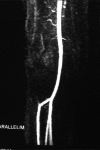Pseudoaneurysm of the anterior tibial artery: A rare complication of proximal tibial steinman pin insertion
- PMID: 21430875
- PMCID: PMC3051127
- DOI: 10.4103/0019-5413.77140
Pseudoaneurysm of the anterior tibial artery: A rare complication of proximal tibial steinman pin insertion
Abstract
An anterior tibial artery pseudoaneurysm is a rare and unexpected complication of Steinmann pin insertion. We describe the case of an 18-year-old boy, who sustained such an injury to the anterior tibial artery during this procedure. Diagnosis was confirmed on a magnetic resonance (MR) angiogram. Aneurysmal sac excision with lateral repair of the vessel wall was performed. Postoperatively, a good flow was documented on a follow-up MR angiogram. This case highlights a major and unexpected complication of a so-called minor procedure. Too posterior a pin placement in the proximal tibia should be avoided to prevent such injuries.
Keywords: Anterior tibial artery; Steinmann pin; pseudoaneurysm.
Conflict of interest statement
Figures






References
-
- Charles K, Fitts WT. The incidence of complications in the use of transfixation pins and wires for skeletal traction. Ann Surg. 1946;123:27–31. - PubMed
-
- Stewart John DM, Hallett Jeffrey P. 2nd ed. Edinburgh: Churchill Livingstone; 1983. Traction and orthopaedic appliances.
-
- Starling S, Ellis H. Edinburgh: Churchill Livingstone; 2005. Gray’s Anatomy. The Anatomical Basis of Clinical Practice.
-
- Ladermann A, Stern R, Bettschart V, Riand N. Delayed posttraumatic pseudoaneurysm of the anterior tibial artery mimicking a malignant tumor. Orthopaedics. 2008;31:500. - PubMed
-
- Dominguez R, de Santos LA. Traumatic pseudoaneurysm of the anterior tibial artery simulating soft tissue malignancy. Skeletal Radiol. 1986;15:622–4. - PubMed
LinkOut - more resources
Full Text Sources
